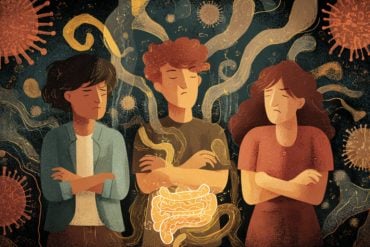Summary: A new study linked higher prenatal exposure to certain phthalates with reduced gray matter in children’s brains by age 10. This exposure was also correlated with decreased IQ levels in the offspring at age 14.
The research underscored that the connection between phthalate exposure and reduced IQ was partly due to alterations in gray matter volumes. Additionally, prenatal exposure resulted in decreased white matter volumes in female children.
Key Facts:
- Phthalates, commonly used in a range of commercial products, have been connected with cognitive and behavioral issues in children.
- The research, based on 775 mother-child pairs, determined that specific phthalate metabolites like mEP and mIBP during pregnancy lead to changes in children’s brain structures.
- Despite small individual differences in brain volume and IQ, the widespread exposure to phthalates and lax regulations present a significant public health concern.
Source: ISGLOBAL
Children whose mothers had a higher exposure to certain phthalates during pregnancy tend to show smaller total gray matter in their brains at age 10.
This is one of the main conclusions of a study led by the NYU Grossman School of Medicine and the Barcelona Institute for Global Health (ISGlobal), a centre supported by the “la Caixa” Foundation, and published in Molecular Psychiatry.
The study also found that maternal exposure to plasticizers during pregnancy is associated with lower child IQ at age 14, which confirmed the results of two previous study on the topic.

Moreover, the research team observed that total gray matter volumes partially influence this relationship between exposure to certain phthalates and lower child IQ. In other words: exposure to plasticizers before birth could lead to smaller total gray matter in childhood, which in turn could be related to a lower IQ.
Finally, the results showed an association between gestational exposure to plasticizers and smaller white matter volumes in girls.
Phthalates, a group of chemicals of concern
Phthalates are a group of chemicals which are ubiquitously used as plasticizers and solvents in a wide range of commercial products, such as personal care products, food packaging or vinyl flooring. Previous studies have shown that certain phthalates are associated with less optimal cognitive function, social development, and motor skills as well as behavioral problems in children.
In order to provide new evidences, the authors used data from 775 mother-child pairs from Generation R, a pediatric neuroimaging cohort based in Rotterdam (The Netherlands). Phthalate exposure of mothers was assessed using urine samples collected during pregnancy.
Since phthalates are difficult to detect due to their rapid decay in the human body, the analysis of the samples focused on detecting phthalate metabolites, the breakdown products generated as the consequence of the presence phthalates.
Brain volumetric measures of children were taken using MRI scans at age 10. Lastly, children’s IQ was assessed via standard tests performed when children were 14 years old.
Results
The statistical analysis revealed an association between higher gestational concentrations of monoethyl phthalate (mEP) and smaller total gray matter volumes in offspring at age 10. mEP is a metabolite, or breakdown product, of diethyl phthalate, a compound used to make plastics more flexible and in cosmetic products.
Higher maternal concentrations in urine during pregnancy of monoisobutyl phthalic acid (mIBP), a metabolite of diisobutyl phthalate (DIBP), were associated with smaller white matter only in girls. DIBP is also used as a plasticizer.
Gray matter is the tissue that contains most of the brain’s neuronal cell bodies and help us process information and govern our muscles. This part of the brain is essential in our ability to learn and retain information, speak, move or process sensation and perceptions.
In turn, white matter is a brain tissue that acts as a communication network between the different gray matter areas and between our brain and the rest of our body.
Lower IQ at age 14
In 2020 and 2021, the Generation R Study reported that maternal prenatal urinary concentrations of phthalates were associated with lower non-verbal IQ at age 6 years. After showing that the association persists at age 14, the authors state that “the impact of phthalate exposure on the brain and child cognition continues into adolescence”.
The new study estimates that 18% of the total effect of phthalate exposure in pregnancy on children’s IQ could be explained by changes in gray matter volumes in both boys and girls. In girls, the association between gestational exposure to mIBP and lower IQ was found to be due to smaller cerebral white matter in a proportion of 76%.
Small differences at individual level
“Even though the observed differences in volumetric measures and IQ scores were small at individual level, it is the wide picture what shows reasons for concern because of the widespread exposure to phthalates and poor regulations, which lead to a high public health impact”, says Mònica Guxens, ISGlobal researcher and last author of the study.
“In the light of scientific evidences on their health effects, countries such as the US or regions such as the EU have increased the regulations of these ubiquitous compounds. However, the use of new compounds to replace the regulated ones leads to a persistence of the global impact of prenatal exposure to phthalates”, says Akhgar Ghassabian, researcher at the NYU School of Medicine.
About this neurodevelopment research news
Author: Pau Rubio
Source: ISGLOBAL
Contact: Pau Rubio – ISGLOBAL
Image: The image is credited to Neuroscience News
Original Research: Closed access.
“Prenatal exposure to common plasticizers: a longitudinal study on phthalates, brain volumetric measures, and IQ in youth” by Mònica Guxens et al. Molecular Psychiatry
Abstract
Prenatal exposure to common plasticizers: a longitudinal study on phthalates, brain volumetric measures, and IQ in youth
Exposure to phthalates, used as plasticizers and solvents in consumer products, is ubiquitous. Despite growing concerns regarding their neurotoxicity, brain differences associated with gestational exposure to phthalates are understudied.
We included 775 mother-child pairs from Generation R, a population-based pediatric neuroimaging study with prenatal recruitment, who had data on maternal gestational phthalate levels and T1-weighted magnetic resonance imaging in children at age 10 years. Maternal urinary concentrations of phthalate metabolites were measured at early, mid-, and late pregnancy.
Child IQ was assessed at age 14 years. We investigated the extent to which prenatal exposure to phthalates is associated with brain volumetric measures and whether brain structural measures mediate the association of prenatal phthalate exposure with IQ.
We found that higher maternal concentrations of monoethyl phthalate (mEP, averaged across pregnancy) were associated with smaller total gray matter volumes in offspring at age 10 years (β per log10 increase in creatinine adjusted mEP = −10.7, 95%CI: −18.12, −3.28).
Total gray matter volumes partially mediated the association between higher maternal mEP and lower child IQ (β for mediated path =−0.31, 95%CI: −0.62, 0.01, p = 0.05, proportion mediated = 18%).
An association of higher monoisobutyl phthalate (mIBP) and smaller cerebral white matter volumes was present only in girls, with cerebral white matter volumes mediating the association between higher maternal mIBP and lower IQ in girls.
Our findings suggest the global impact of prenatal phthalate exposure on brain volumetric measures that extends into adolescence and underlies less optimal cognitive development.






